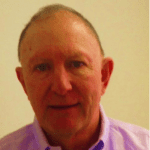It caught my eye immediately. A statue on his desk—a bullfight scene.
But not what you would expect. This one was strikingly different—here the bull was sitting on the matador holding him down! Talk about the unexpected. A paradigm shift? No, a complete reversal!
We need more of this. Not bullfights, but visualizing reversals of what we’ve come to expect.
We see poverty all around, and in so many different forms. Yet poverty is made by humans, and therefore can be changed. It need not be inevitable. Visualizing the opposite of current reality can lead to new insights and understandings.
 The well-known pastoral method of SEE-JUDGE-ACT does exactly that. The three-step process guides us from understanding to effective action. It is an invaluable tool for those who wish to accomplish something lasting and significant.
The well-known pastoral method of SEE-JUDGE-ACT does exactly that. The three-step process guides us from understanding to effective action. It is an invaluable tool for those who wish to accomplish something lasting and significant.
SEE
Seeing, in this context, changes the way we look at the reality around us. To “see” is not to glance or to notice, but to look deeply, to grasp, to understand. Patterns and systems emerge clearly. Seeing means analyzing a reality, coming fully to terms with its meaning. If we cannot “see” and analyze the world around us as it really is, we will never make significant change.
JUDGE
This process changes what we think of reality. It leads us to ask why things are this way. We discover that they are not set in stone, and need not be permanent. Poverty, for example, although present all around us, is not inevitable. Poverty may be historical and deeply rooted, but again—- it is worthwhile repeating– it is made by humans, it is sustained by people’s unjust socio-economic and political decisions and absolute disregard for the “common good.” And that can be changed.
We base our judgment on our values. And so we ask, what does scripture say about this reality? How about church teaching, especially Catholic Social Teaching? Is this reality what God wants for us? In the bright light of these treasured sources, we reflect critically about what we have seen, and resolve to do something based on our values and beliefs.
ACT
This phase revolves around resolving to respond effectively in ways based on our value judgments. And to so decisively, undaunted by opposition or the enormity of the challenge. We begin small, like sowing seeds, moving on to the more difficult. From the simple to the complex. This may involve advocacy. It will certainly call for community organizing of some kind or quantity. It will definitely mean careful and continual planning.
We will have choices: will our advocacy for positive change in people’s lives, especially those of the poor, be timid or bold? Are we capable of “disrupting” the status quo in some way before “rebuilding” again, in the words of the bishop of San Diego? We will choose where and how to best use our own talents. Since our Vincentian mission always begins (and ends) with God’s poor, it may be trying to make our charitable efforts more empowering of the poor. We may look further as well, seeking initiatives that seem promising for widespread social impact by changing structures and systems to foster greater justice and dignity in the lives of the impoverished.
There are other solid pastoral methods or processes, but See-Judge-Act has proven, for many, a valuable tool in effecting real and lasting change. And thinking of the bull atop the matador doesn’t hurt either.
 Jim Claffey just retired from the St. Vincent de Paul Society on Long Island, where he served as Director of Formation and Programs. Jim currently serves as the executive secretary of the Vincentian Family’s International Commission to Promote Systemic Change.
Jim Claffey just retired from the St. Vincent de Paul Society on Long Island, where he served as Director of Formation and Programs. Jim currently serves as the executive secretary of the Vincentian Family’s International Commission to Promote Systemic Change.







A great memorable analogy Jim! Visual examples – quirky especially – stay long in the memory! Our Mini Vinnies (age 5-11) here in UK use See-Think-Act for their consideration of social justice projects for those people living in poverty. Thanks!